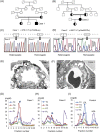Two novel mutations of lecithin:cholesterol acyltransferase (LCAT) gene and the influence of APOE genotypes on clinical manifestations
- PMID: 25984174
- PMCID: PMC4421733
- DOI: 10.1093/ndtplus/sfr091
Two novel mutations of lecithin:cholesterol acyltransferase (LCAT) gene and the influence of APOE genotypes on clinical manifestations
Abstract
Familial lecithin:cholesterol acyltransferase deficiency (FLD) is an autosomal recessive disorder characterized by corneal opacity, hemolytic anemia, low high-density lipoprotein cholesterol (HDL-C) and proteinuria. Two novel lecithin:cholesterol acyltransferase (LCAT) mutations[c.278 C>T (p.Pro69Leu); c.950 T>C (p.Met293Thr)] were identified in a 27-year-old man and in a 30-year-old woman, respectively. Both patients manifested corneal opacity, hemolytic anemia, low low-density lipoprotein cholesterol and HDL-C and proteinuria. Lipid deposits with vacuolar lucent appearance in glomerular basement membranes were observed in both cases. APOE genotype was also investigated: the first case results ϵ4/ϵ3, the second ϵ2/ϵ2; however, they shared a similar phenotype characterized by the presence of intermediate-density lipoproteins (IDL) remnant and the absence of lipoprotein-X. In conclusion, our findings suggest that APOE ϵ2/ϵ2 may not be the major determinant gene for the appearance of IDL in FLD patients.
Keywords: APOE genotype; IDL remnant; familial LCAT deficiency (FLD); lipoprotein-X.
Figures

References
-
- Kuivenhoven JA, Pritchard H, Hill J, et al. The molecular pathology of lecithin:cholesterol acyltransferase (LCAT) deficiency syndromes. J Lipid Res. 1997;38:191–205. - PubMed
-
- Funke H, von Eckardstein A, Pritchard PH, et al. Genetic and phenotypic heterogeneity in familial lecithin: cholesterol acyltransferase (LCAT) deficiency. Six newly identified defective alleles further contribute to the structural heterogeneity in this disease. J Clin Invest. 1993;91:677–683. - PMC - PubMed
-
- Guerin M, Dolphin PJ, Chapman MJ. Familial lecithin:cholesterol acyltransferase deficiency: further resolution of lipoprotein particle heterogeneity in the low density interval. Atherosclerosis. 1993;104:195–212. - PubMed
-
- Lambert G, Sakai N, Vaisman BL, et al. Analysis of glomerulosclerosis and atherosclerosis in lecithin cholesterol acyltransferase-deficient mice. J Biol Chem. 2001;276:15090–15098. - PubMed
-
- Baass A, Wassef H, Tremblay M, et al. Characterization of a new LCAT mutation causing familial LCAT deficiency (FLD) and the role of APOE as a modifier gene of the FLD phenotype. Atherosclerosis. 2009;207:452–457. - PubMed
Publication types
LinkOut - more resources
Full Text Sources
Miscellaneous
